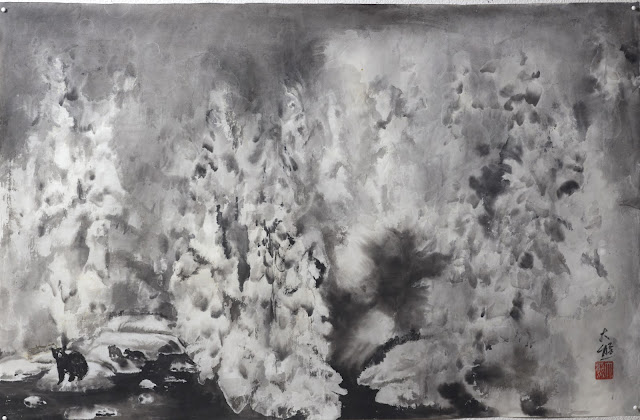I had fun with the snow contrasted by the dark water. I thought it looked stunning. My new project must involve snow and dark water. How about placing a snowy mountain with the foothill woodland in the background for good measure. A screen saver used by the local Public Broadcasting audio channel fit the bill perfectly. I'll paint that.
A horrible thought came to mind. A small painting was not going to emanate the aura of a grand landscape. I should try something bigger perhaps.
Luck will have it that I bought a surplus frame for very little moolah and it measures 4 ft x 2 ft. My Xuan stock is 54 in x 27 in ( notice the 2:1 ratio ) so I have no problem with the raw material.
Armed with the new found curiosity and confidence, and perhaps a little arrogance, I started my painting.
My big painting.
I shall start from the foreground and work my way to the mountain in the back. I shall be using the alum solution to depict snow. Thus instead of leaving a void I am actually painting the void spaces too, albeit with the clear alum solution. What I am going to do a little differently this time is to paint everything on one side of the paper first instead of constantly switching from front to back etc. I ended up confusing myself since I liked the effects from both sides of the paper. After I am done with the one side, I will flip the paper over and work on the back side and make my call after everything is done.
So the foreground is basically a large spread of flat snow covered ground with a stream running in the middle.
I painted in the left bank of stream, creating a few slopes to add interest to a otherwise flat feature.
Placed my right bank, using a little ink to create shading, giving the bank dimension.
I finished constructing the banks of the stream. I wasn't going to do anything to the rest of the snowy plain, since it was going to be white. I folded a crease in my paper and that would be the edge of the woodland at the foothill.
Time to conquer my mountain.
I began by writing in my snow using the alum solution.
I used a smaller brush because I wanted to make smaller lines, wanting to add texture to the snow.
With my brush soaked with ink and alum solution, I started my tree planting exercise. The creased line in the paper facilitated in the positioning of the trunks.
Took the opportunity to write in many dots with the alum solution. The plan was to have these dots appear as lighter than the surrounding, giving an air of snow cover on leaves and branches.
Using a darker ink, I filled in the stream.
It was interesting to see the darker ink tried to obscure the alum solution painted snow, but only partially. I seemed to have found a way to express submerged snow or ice.
Using different tones of ink now, going over the areas of the mountain and the woodland, I brought out what was hidden beneath the ink tone.

















































